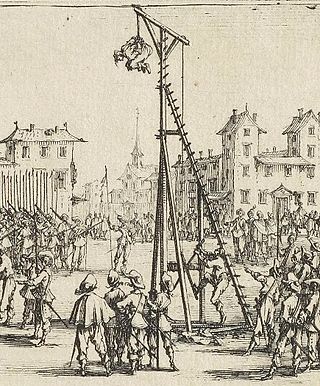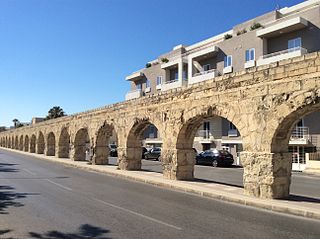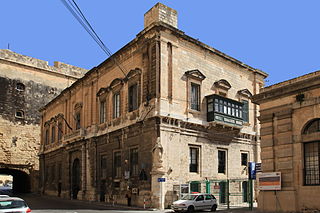See also
- Castellan, the governor or captain of a castellany and its castle
- Castellana (disambiguation)
A castellania was the smallest administrative subdivision of land in parts of medieval Europe.
Castellania may also refer to:

Valletta is the capital city of Malta and one of its 68 council areas. Located between the Grand Harbour to the east and Marsamxett Harbour to the west, its population as of 2021 was 5,157. As Malta’s capital city, it is a commercial centre for shopping, bars, dining, and café life. It is also the southernmost capital of Europe, and at just 0.61 square kilometres (0.24 sq mi), it is the European Union's smallest capital city.

The strappado, also known as corda, is a form of torture in which the victim's hands are tied behind their back and the victim is suspended by a rope attached to the wrists, typically resulting in dislocated shoulders. Weights may be added to the body to intensify the effect and increase the pain. This kind of torture would generally not last more than an hour without rest, as it would otherwise likely result in death.
Various residences for archbishops are locally known as the Archbishop's Palace, including the following:
Bishop's Palace may refer to the official residence of any bishop, such as those listed in the Category:Episcopal palaces.
Palace of Justice may refer to:

Carnival has had an important place on the Maltese cultural calendar for just under five centuries, having been celebrated since at least the mid-15th century. Carnival has been a prominent celebration in the Islands since the rule of Grand Master Piero de Ponte in 1535.

The Castellania, also known as the Castellania Palace, is a former courthouse and prison in Valletta, Malta that currently houses the country's health ministry. It was built by the Order of St. John between 1757 and 1760, on the site of an earlier courthouse which had been built in 1572.

The Inquisitor's Palace, also known as the Sacred Palace, is a palace in Birgu, Malta. It was the seat of the Maltese Inquisition from 1574 to 1798, under the name Palazzo del Sant'Officio. The building was originally constructed as a courthouse known as the Castellania in the early 16th century, but little remains of the original building due to major alterations and renovations carried out in the subsequent centuries.
Governor's Palace may refer to:

The Wignacourt Aqueduct is a 17th-century aqueduct in Malta, which was built by the Order of Saint John to carry water from springs in Dingli and Rabat to the newly built capital city Valletta. The aqueduct carried water through underground pipes and over arched viaducts across depressions in the ground.

The Auberge d'Auvergne was an auberge in Valletta, Malta. It was built in the 16th century to house knights of the Order of Saint John from the langue of Auvergne. It became a courthouse in the 19th century, and it remained so until it was destroyed by aerial bombardment in 1941. The site is now occupied by the Courts of Justice building, which was constructed in the 1960s.
King's Garden may refer to:
Grand Master's Palace most often refers to:
Municipal Palace may refer to the following buildings:

The Corte Capitanale is a former courthouse in Mdina, Malta, which currently serves as a city hall. It was built in the Baroque style between 1726 and 1728, to designs of the French architect Charles François de Mondion. The building is linked to Palazzo Vilhena, but it has its own entrance and façade.

The Monte di Pietà, formerly known as the Monte di Sant'Anna, is a charitable institution which lends money to those in need at modest interest rates, on the security of gold, silver or other precious articles given in pawn. In Malta the institution was set up in 1598, was known in the British period as the Public Pawn-Brokery, and it is still in operation today as part of the Inland Revenue Department. Since 1773, the Monte di Pietà has been housed in a 16th-century building in Valletta.

Maltese Baroque architecture is the form of Baroque architecture that developed in Malta during the 17th and 18th centuries, when the islands were under the rule of the Order of St. John. The Baroque style was introduced in Malta in the early 17th century, possibly by the Bolognese engineer Bontadino de Bontadini during the construction of the Wignacourt Aqueduct. The style became popular in the mid to late 17th century, and it reached its peak during the 18th century, when monumental Baroque structures such as Auberge de Castille were constructed.
Francesco "Franco" Zerafa was a Maltese architect and donato to the Religion. In 1714, he succeeded Giovanni Barbara as Capomastro delle Opere della Religione, a post which he held until his death.

Giuseppe Bonici (1707–1779) was a Maltese architect and military engineer. He held the post of Capomastro delle Opere della Religione and was the principal architect of the Order of St. John from 1761 until his death. He designed several notable buildings; his masterpiece was the Customs House in Valletta.
Pietro Dusina was an Italian Roman Catholic priest from Brescia who was the inquisitor and apostolic delegate to Malta between 1574 and 1575.